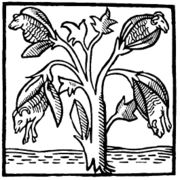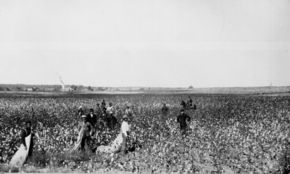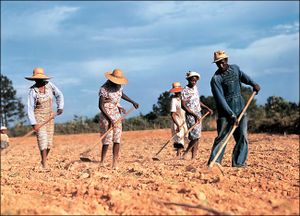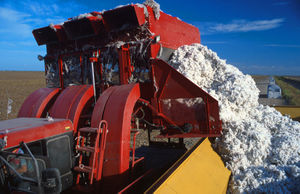Cotton
2007 Schools Wikipedia Selection. Related subjects: Plants
Cotton is a soft fibre that grows around the seeds of the cotton plant (Gossypium spp.), a shrub native to the tropical and subtropical regions of Africa and the Americas. The fibre is most often spun into thread and used to make a soft, breathable textile, which is the most widely used natural-fiber cloth in clothing today. The English name descends from the Arabic word "al qutun", (hence also came the Spanish word "algodón") meaning cotton fibre. Africa and South America are large providers of cotton.
Cotton fibre (once processed to remove seeds and traces of wax, protein, etc.) consists of nearly pure cellulose, a natural polymer. Cotton production is very efficient, in the sense that, ten percent or less of the weight is lost in subsequent processing to convert the raw cotton bolls into pure fibre. The cellulose is arranged in a way that gives cotton fibers a high degree of strength, durability, and absorbency. Each fibre is made up of twenty to thirty layers of cellulose coiled in a neat series of natural springs. When the cotton boll (seed case) is opened the fibres dry into flat, twisted, ribbon-like shapes and become kinked together and interlocked. This interlocked form is ideal for spinning into a fine yarn.
Cultivation
Successful cultivation of cotton requires a long growing season, plenty of sunshine and water during the period of growth, and dry weather for harvest. In general, these conditions are met within tropical and warm subtropical latitudes in the Northern and Southern hemispheres. Production of the crop for a given year usually starts soon after harvesting the preceding autumn. Planting time in spring varies from the beginning of February to the beginning of June.
Cotton plant
Cotton fibre originates from the cotton plant, an important crop in tropical climates and warm temperate climates. Commercial species of cotton plant are Gossypium hirsutum (U.S.A. and Australia), G. arboreum, G. herbaceum (Asia), and G. barbadense (Egypt).
History

Cotton has been used to make very fine lightweight cloth in areas with tropical climates for millennia. Evidence has been found of cotton in Mexican caves (cotton cloth and fragments of bloody fibre interwoven with feathers and fur) which dated back to approximately 7,000 years ago. There is clear archaeological evidence that people in India and South America domesticated different species of cotton independently thousands of years ago.
Cotton cultivation in the Old World began from India, where cotton has been grown for more than 6,000 years, since the pre-Harappan period. Cotton from the Harappan civilization was exported to Mesopotamia during the 3rd millenium BC, and cotton was soon known to the Egyptians as well. The Rig Veda, composed from around the 15th century BC, contains numerous references to cotton. The famous Greek historian Herodotus also wrote about Indian cotton: "There are trees which grow wild there, the fruit of which is a wool exceeding in beauty and goodness that of sheep. The Indians make their clothes of this tree wool." (Book III. 106)
In Peru, cotton was the backbone of the development of coastal cultures such as the Moche and Nazca. Cotton was grown upriver, made into nets and traded with fishing villages along the coast for large supplies of fish. The Spanish who came to Mexico in the early 1500s found the peoples there wearing cotton clothing and growing it.
During the late mediaeval period, cotton became known as an imported fibre in northern Europe, without any knowledge of what it came from other than that it was a plant; noting its similarities to wool, people in the region could only imagine that cotton must be produced by plant-borne sheep. John Mandeville, writing in 1350, stated as fact the now-preposterous belief: "There grew there India a wonderful tree which bore tiny lambs on the endes of its branches. These branches were so pliable that they bent down to allow the lambs to feed when they are hungrie." This aspect is retained in the name for cotton in many European languages, such as German Baumwolle, which translates as "tree wool". By the end of the 16th century, cotton was cultivated throughout the warmer regions in Asia and the Americas.
India's cotton-processing sector gradually declined during British expansion in India and the establishment of colonial rule during the late 18th and early 19th centuries. This was largely due to the East India Company's de-industrialization of India, which forced the closing of cotton processing and manufacturing workshops in India, to ensure that Indian markets supplied only raw materials and were obliged to purchase manufactured textiles from Britain.
The advent of the Industrial Revolution in Britain provided a great boost to cotton manufacture, as textiles emerged as Britain's leading export. The invention of the spinning jenny in 1764 and Richard Arkwright's spinning frame in 1769 enabled British weavers to produce cotton yarn and cloth at much higher rates. The UK city of Manchester even became known as Cottonopolis because of its pre-eminance as a world centre of cotton-spinning. Production capacity was further improved by the invention of the cotton gin by Eli Whitney in 1793. Improving technology and increasing control of world markets allowed British traders to develop a commercial chain in which raw cotton fibres were (at first) purchased from colonial plantations, processed into cotton cloth in the mills of Lancashire, and then re-exported on British ships to captive colonial markets in West Africa, India, and China (via Shanghai and Hong Kong).
By the 1840s, India was no longer capable of supplying the vast quantities of cotton fibres needed by mechanised British factories, while shipping bulky, low-price cotton from India to Britain was time-consuming and expensive. This, coupled with the emergence of American cotton as a superior type (due to the stronger fibres of American plants) encouraged British traders to purchase cotton from slave plantations in the United States and the Caribbean. Due to the enormous quantities of raw cotton required to make cheap bulk exports, British industrialists quickly abandoned expensive raw cotton produced in India in favour of mass-produced cotton from the southern United States, which was much cheaper as it was produced by unpaid slaves. By the mid 19th century, " King Cotton" had become the backbone of the southern American economy. In the United States, cultivating and harvesting cotton became the leading occupation of slaves.
During the American Civil War, American cotton exports slumped due to a Union blockade on Southern ports, prompting the main purchasers of cotton, Britain and France, to turn to Egyptian cotton. British and French traders invested heavily in cotton plantations and the Egyptian government of Viceroy Isma'il took out substantial loans from European bankers and stock exchanges. After the American Civil War ended in 1865, British and French traders abandoned Egyptian cotton and returned to cheap American exports, sending Egypt into a deficit spiral that led to the country declaring bankruptcy in 1876, a key factor behind Egypt's annexation by the British Empire in 1882.
During this time cotton cultivation in British Empire , especially India, greatly increased to replace the lost production of the American South which had been the main supplier to the English mills. Through tariffs and other restrictions the English government discouraged the production of cotton cloth in India; rather the raw fibre was sent to England for processing. The Indian patriot Gandhi described the process:
- 1. You English buy Indian cotton in the field, picked by Indian labor at seven cents a day, through an optional monopoly.
- 2. This cotton is shipped on British bottoms, a three weeks journey across the Indian Ocean, down the Red Sea, across the Mediterranean, through Gibraltar, across the Bay of Biscay and the Atlantic Ocean to London. One hundred per cent profit on this freight is regarded as small.
- 3. The cotton is turned into cloth in Lancashire. You pay shilling wages instead of Indian pennies to your workers. The English worker not only has the advantage of better wages, but the steel companies of England get the profit of building the factories and machines. Wages; profits; all these are spent in England.
- 4. The finished product is sent back to India at European shipping rates, once again on British ships. The captains, officers, sailors of these ships, whose wages must be paid, are English. The only Indians who profit are a few lascars who do the dirty work on the boats for a few cents a day.
- 5 The cloth is finally sold back to the kings and landlords of India who got the money to buy this expensive cloth out of the poor peasants of India who worked at seven cents a day. (Fisher 1932 pp 154-156)
- 2. This cotton is shipped on British bottoms, a three weeks journey across the Indian Ocean, down the Red Sea, across the Mediterranean, through Gibraltar, across the Bay of Biscay and the Atlantic Ocean to London. One hundred per cent profit on this freight is regarded as small.
In the United States, cotton remained a key crop in the southern economy after emancipation and the end of the civil war in 1865. Across the south, sharecropping evolved, in which free black farmers worked on white-owned cotton plantations in return for a share of the profits (although in reality, the system was little changed from the days of slavery). Cotton plantations required vast labour forces to hand-pick cotton fibres, and it was not until the 1950s that reliable harvesting machinery was introduced into the South (prior to this, cotton-harvesting machinery had been too clumsy to pick cotton without shredding the fibres). During the early twentieth century, employment in the cotton industry fell as machines began to replace labourers, and as the South's rural labour force dwindled during the First and Second World Wars. Today, cotton remains a major export of the southern United States, and a majority of the world's annual cotton crop is of the long-staple American variety.
The cotton industry relies heavily on chemicals such as fertilizers and insecticides, although a very small number of farmers are moving towards an organic model of production and organic cotton products are now available for purchase at limited locations.
Historically, in North America, one of the most economically destructive pests in cotton production has been the boll weevil. Due to the US Department of Agriculture's highly successful Boll Weevil Eradication Program (BWEP), this pest has been eliminated from cotton in most of the United States. This program, along with the introduction of genetically engineered " Bt cotton" containing a bacteria gene that codes for a plant-produced protein that is toxic to a number of pests such as tobacco budworm, cotton bollworm and pink bollworm, has allowed a reduction in the use of synthetic insecticides.
Most cotton in the United States, Europe and Australia is harvested mechanically, either by a cotton picker, a machine that removes the cotton from the boll without damaging the cotton plant, or by a cotton stripper which strips the entire boll off the plant. Cotton strippers are generally used in regions where it is too windy to grow picker varieties of cotton and generally used after application of a defoliant or natural defoliation occurring after a freeze. Cotton is a perennial crop in the tropics and without defoliation or freezing, the plant will continue to grow.
The logistics of cotton harvesting and processing have been improved by the development of the cotton module builder, a machine that compresses harvested cotton into a large block, which is then covered with a tarp and temporarily stored at the edge of the field.
Research and promotion
Beginning as a self-help program in the mid-1960s, the Cotton Research & Promotion Program was organized by U.S. Upland cotton producers in response to cotton's steady decline in market share. At that time, producers voted to set up a per-bale assessment system to fund the Program with built-in safeguards to protect their investments. With the passage of the Cotton Research & Promotion Act of 1966, the Program joined forces and began battling synthetic competitors and re-establishing markets for cotton. Today, the success of this Program has made cotton the best selling fibre in the U.S. and one of the best selling fibers in the world.
Administered by the Cotton Board and conducted by Cotton Incorporated, the Cotton Research & Promotion Program is the program that is continuously working to increase the demand for and profitability of cotton through various research and promotion activities. The Program is funded by U.S. cotton producers and importers.
Uses
Cotton is used to make a number of textile products. These include terrycloth, used to make highly absorbent bath towels and robes, denim, used to make blue jeans, chambray, popularly used in the manufacture of blue work shirts (from which we get the term " blue-collar"), along with corduroy, seersucker, and cotton twill. Socks, underwear, and most T-shirts are made from cotton. Bed sheets are also often made from cotton. Cotton is also used to make yarn used in crochet and knitting. Fabric can also be made from recycled or recovered cotton that would otherwise be thrown away during the spinning, weaving or cutting process. While many fabrics are made completely of cotton, some materials blend cotton with other fibers, including rayon and synthetic fibers such as polyester.
In addition to the textile industry, cotton is used in fishnets, coffee filters, tents and in bookbinding. The first Chinese paper was made of cotton fibre, as is the modern US dollar bill and federal stationery. Fire hoses were once made of cotton.
The cottonseed which remains after the cotton is ginned is used to produce cottonseed oil, which after refining can be consumed by humans like any other vegetable oil. The cottonseed meal that is left is generally fed to livestock. In the past, cotton seeds were used by women as an abortifacient.
Cotton linters are fine, silky fibers which adhere to the seeds of the cotton plant after ginning. These curly fibers are typically less than 1/8in, 3mm long. The term may also apply to the longer textile fibre staple lint as well as the short fuzzy fibers from some upland species. Linters are traditionally used in the manufacture of paper and as a raw material in the manufacture of cellulose.
Pests
The greatest ecological threat to cotton plants is the boll weevil. During the late nineteenth century and early twentieth century, boll weevil infestations caused significant damage to annual cotton crops in the southern United States, resulting in frequent economic depressions in rural areas.
Fair trade
Cotton is an enormously important commodity throughout the world. However, many farmers in developing countries receive a low price for their produce, or find it difficult to compete with developed countries.
This has led to an international dispute:
On 27 September 2002 Brazil requested consultations with the US regarding prohibited and actionable subsidies provided to US producers, users and/or exporters of upland cotton, as well as legislation, regulations, statutory instruments and amendments thereto providing such subsidies (including export credits), grants, and any other assistance to the US producers, users and exporters of upland cotton.
On 8 September 2004, the Panel Report recommended that the United States "withdraw" export credit guarantees and payments to domestic user and exporters, and "take appropriate steps to remove the adverse effects or withdraw" the mandatory price-contingent subsidy measures. The international production and trade situation has led to ' fair trade' cotton clothing or footwear ( Veja Sneakers) being available in some countries. The fair trade system was initiated in 2005 with producers from Cameroon, Mali and Senegal.
Critical Temperatures
- Favorable travel temperature range - no lower limit =< 77°F (25°C)
- Optimum travel temperature - 68°F (20°C)
- Autoignition temperature (for oily cotton) - 248°F (120°C)
- Glow temperature - 401°F (205°C)
- Fire point - 410°F (210°C)
- Autoignition temperature - 765°F (407°C)
Cotton dries out, becomes hard and brittle and loses all elasticity at temperatures above 25°C. Extended exposure to light causes similar problems.
A temperature range of 25°C to 35°C is the optimal range for mold development. At temperatures below 0°C, rotting of wet cotton stops. Damaged cotton is sometimes stored at these temperatures to prevent further deterioration.
Old British cotton yarn measures
- 1 thread = 54 inches (about 137 cm)
- 1 skein or rap = 80 threads (120 yards or about 109 m)
- 1 hank = 7 skeins (840 yards or about 768 m)
- 1 spindle = 18 hanks (15,120 yards or about 13,826 m)






